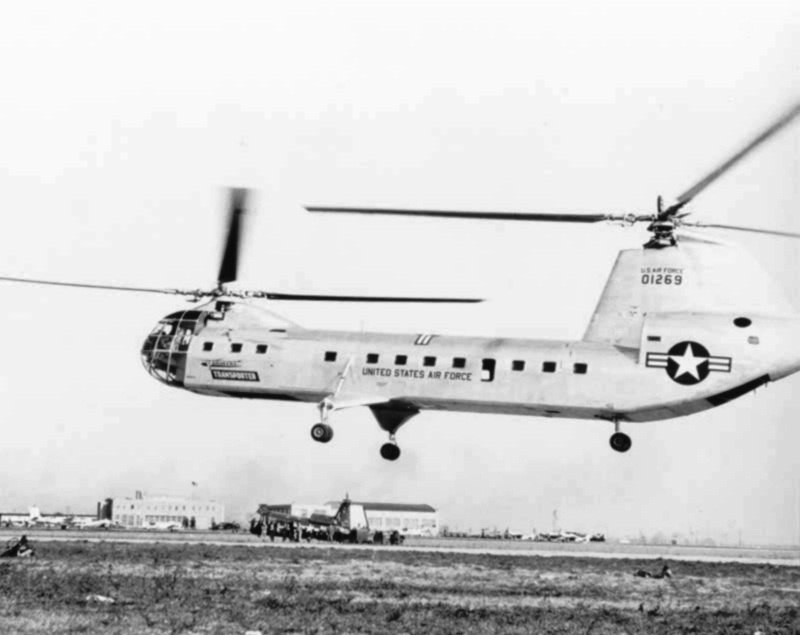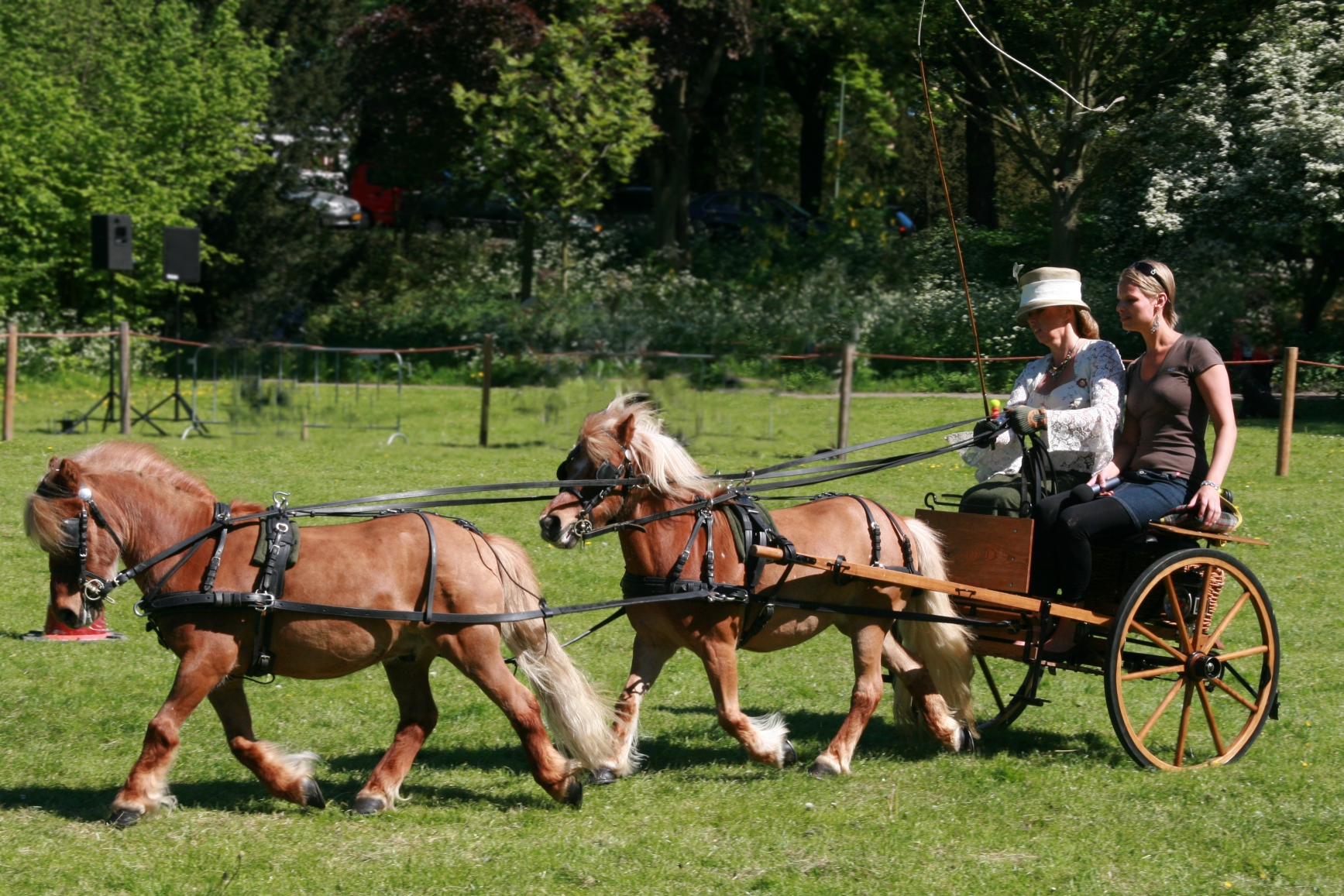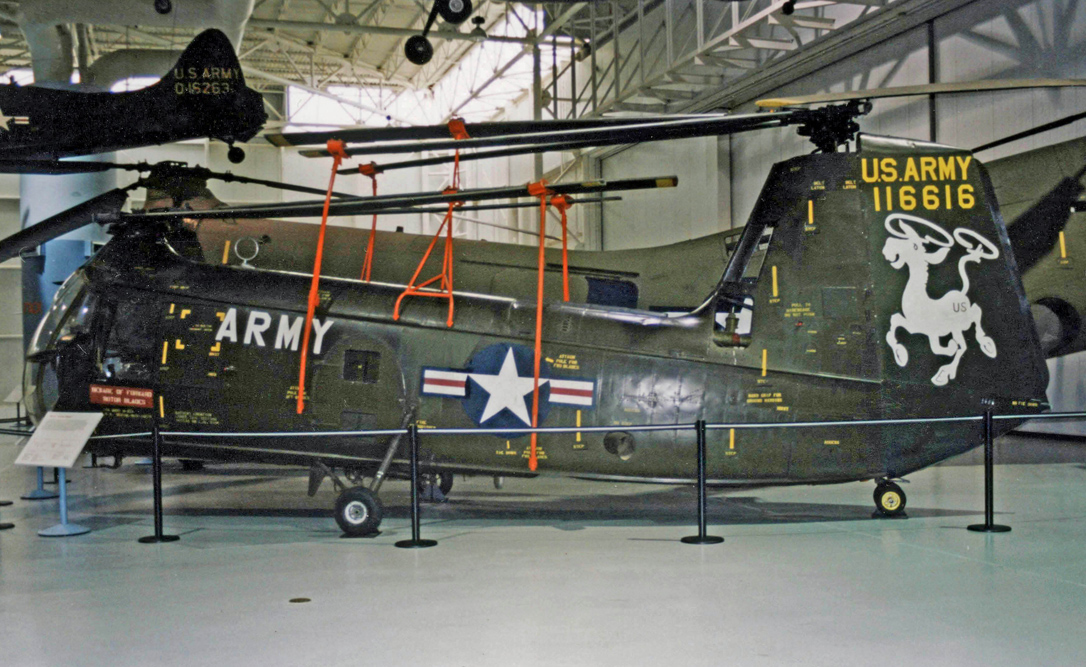|
Piasecki H-16
The Piasecki H-16 Transporter (company designation PV-15) was a tandem-rotor transport or rescue helicopter designed by Frank Piasecki and built by Piasecki Helicopter. The prototypes were evaluated by the United States Air Force and Army, but the crash of the second test aircraft led to cancelling the project. Design and development Given the company designation PV-15, the tandem-rotor helicopter was designed by company founder Frank Piasecki. The design was publicly shown for the first time on 15 September 1953 at the Philadelphia airport. Operational history Crash On 5 January 1956, the second YH-16 test aircraft crashed while returning to Philadelphia from a test flight over New Jersey.Piasecki Helicopter Corporation newsletter, January 1956 The cause of the crash was later determined to be the aft slip ring, which carried flight data from the instrumented rotor blades to the data recorders in the cabin. The slip ring bearings seized, and the resultant torque load severed ... [...More Info...] [...Related Items...] OR: [Wikipedia] [Google] [Baidu] |
WikiProject Aircraft
A WikiProject, or Wikiproject, is a Wikimedia movement affinity group for contributors with shared goals. WikiProjects are prevalent within the largest wiki, Wikipedia, and exist to varying degrees within sister projects such as Wiktionary, Wikiquote, Wikidata, and Wikisource. They also exist in different languages, and translation of articles is a form of their collaboration. During the COVID-19 pandemic, CBS News noted the role of Wikipedia's WikiProject Medicine in maintaining the accuracy of articles related to the disease. Another WikiProject that has drawn attention is WikiProject Women Scientists, which was profiled by '' Smithsonian'' for its efforts to improve coverage of women scientists which the profile noted had "helped increase the number of female scientists on Wikipedia from around 1,600 to over 5,000". On Wikipedia Some Wikipedia WikiProjects are substantial enough to engage in cooperative activities with outside organizations relevant to the field at issue. For e ... [...More Info...] [...Related Items...] OR: [Wikipedia] [Google] [Baidu] |
Allison T56-A-5
The Allison T56 is an American single-shaft, modular design military turboprop with a 14-stage axial flow compressor driven by a four-stage turbine. It was originally developed by the Allison Engine Company for the Lockheed C-130 Hercules transport entering production in 1954. It has been a Rolls-Royce product since 1995 when Allison was acquired by Rolls-Royce. The commercial version is designated 501-D. Over 18,000 engines have been produced since 1954, logging over 200 million flying hours. Design and development The T56 turboprop, evolved from Allison's previous T38 series, was first flown in the nose of a B-17 test-bed aircraft in 1954. One of the first flight-cleared YT-56 engines was installed in a C-130 nacelle on Lockheed's Super Constellation test aircraft in early 1954. Originally fitted to the Lockheed C-130 Hercules military transport aircraft, the T56 was also installed on the Lockheed P-3 Orion maritime patrol aircraft (MPA), Grumman E-2 Hawkeye airborne early ... [...More Info...] [...Related Items...] OR: [Wikipedia] [Google] [Baidu] |
Military Transport Helicopters
A military, also known collectively as armed forces, is a heavily armed, highly organized force primarily intended for warfare. It is typically authorized and maintained by a sovereign state, with its members identifiable by their distinct military uniform. It may consist of one or more military branches such as an army, navy, air force, space force, marines, or coast guard. The main task of the military is usually defined as defence of the state and its interests against external armed threats. In broad usage, the terms ''armed forces'' and ''military'' are often treated as synonymous, although in technical usage a distinction is sometimes made in which a country's armed forces may include both its military and other paramilitary forces. There are various forms of irregular military forces, not belonging to a recognized state; though they share many attributes with regular military forces, they are less often referred to as simply ''military''. A nation's military may f ... [...More Info...] [...Related Items...] OR: [Wikipedia] [Google] [Baidu] |
Tandem Rotor Helicopters
Tandem, or in tandem, is an arrangement in which a team of machines, animals or people are lined up one behind another, all facing in the same direction. The original use of the term in English was in ''tandem harness'', which is used for two or more draft horses, or other draft animals, harnessed in a single line one behind another, as opposed to a pair, harnessed side by side, or a team of several pairs. The tandem harness allows additional animals to provide pulling power for a vehicle designed for a single animal. The English word ''tandem'' derives from the Latin adverb , meaning ''at length'' or ''finally''. It is a word play, using the Latin phrase (referring to time, not position) for English "at length, lengthwise". Tandem bicycles are named for their tandem seating, a more common arrangement than side-by-side "sociable" seating. ''Tandem'' can also be used more generally to refer to any group of persons or objects working together, not necessarily in line. Automo ... [...More Info...] [...Related Items...] OR: [Wikipedia] [Google] [Baidu] |
1950s United States Helicopters
Year 195 ( CXCV) was a common year starting on Wednesday (link will display the full calendar) of the Julian calendar. At the time, it was known as the Year of the Consulship of Scrapula and Clemens (or, less frequently, year 948 ''Ab urbe condita''). The denomination 195 for this year has been used since the early medieval period, when the Anno Domini calendar era became the prevalent method in Europe for naming years. Events By place Roman Empire * Emperor Septimius Severus has the Roman Senate deify the previous emperor Commodus, in an attempt to gain favor with the family of Marcus Aurelius. * King Vologases V and other eastern princes support the claims of Pescennius Niger. The Roman province of Mesopotamia rises in revolt with Parthian support. Severus marches to Mesopotamia to battle the Parthians. * The Roman province of Syria is divided and the role of Antioch is diminished. The Romans annexed the Syrian cities of Edessa and Nisibis. Severus re-establish his head ... [...More Info...] [...Related Items...] OR: [Wikipedia] [Google] [Baidu] |
1950s United States Military Transport Aircraft
Year 195 ( CXCV) was a common year starting on Wednesday (link will display the full calendar) of the Julian calendar. At the time, it was known as the Year of the Consulship of Scrapula and Clemens (or, less frequently, year 948 '' Ab urbe condita''). The denomination 195 for this year has been used since the early medieval period, when the Anno Domini calendar era became the prevalent method in Europe for naming years. Events By place Roman Empire * Emperor Septimius Severus has the Roman Senate deify the previous emperor Commodus, in an attempt to gain favor with the family of Marcus Aurelius. * King Vologases V and other eastern princes support the claims of Pescennius Niger. The Roman province of Mesopotamia rises in revolt with Parthian support. Severus marches to Mesopotamia to battle the Parthians. * The Roman province of Syria is divided and the role of Antioch is diminished. The Romans annexed the Syrian cities of Edessa and Nisibis. Severus re-establish his ... [...More Info...] [...Related Items...] OR: [Wikipedia] [Google] [Baidu] |
Piasecki Helicopter Aircraft
Piasecki (feminine: Piasecka, plural: Piaseccy) is a Polish language, Polish family name and may refer to one of the following. * Anna Piasecka (1882–1980), Polish politician * Barbara Piasecka Johnson (1937–2013), Polish-American philanthropist and art collector * Bartosz Piasecki (born 1984), Norwegian fencer * Bolesław Piasecki (1915–1979), Polish politician * Edyta Piasecka, Polish soprano * Fabian Piasecki (born 1995), Polish footballer * Francis Piasecki (1951–2018), French footballer * Frank Piasecki (1919–2008), American engineer and founder of two aviation businesses: :* Piasecki Helicopter :* Piasecki Aircraft * Jess Piasecki, British long-distance runner * Lech Piasecki (born 1961), Polish cyclist * Sergiusz Piasecki (1901–1964), Polish writer * Stanisław Piasecki (1900–1941), Polish right-wing activist, politician and journalist * Zofia Posmysz-Piasecka (born 1923), Polish writer * (1893–1954), Polish general, recipient of Virtuti Militari order See a ... [...More Info...] [...Related Items...] OR: [Wikipedia] [Google] [Baidu] |
List Of United States Navy Aircraft Designations (pre-1962)
This list of United States Navy aircraft designations (pre-1962) includes prototype, pre-production and operational type designations under the 1922 United States Navy aircraft designation system, which was used by the United States Navy, the United States Marine Corps, and the United States Coast Guard. The list also includes airships, which were designated under different systems than fixed-wing aircraft and rotorcraft until 1954, and naval aircraft that received designations under the 1911 and 1914 U.S. Navy systems, which were sequential by manufacturer and/or aircraft class, and did not convey information about the aircraft's mission. For aircraft designations under the U.S. Army Air Force/U.S. Air Force system or the post-1962 Tri-Service system—which includes U.S. Navy, Marine Corps and Coast Guard aircraft currently in service—see List of military aircraft of the United States. For Navy, Marine Corps and Coast Guard aircraft that did not receive formal designations� ... [...More Info...] [...Related Items...] OR: [Wikipedia] [Google] [Baidu] |
Yakovlev Yak-24
The Yakovlev Yak-24 (NATO reporting name "Horse") is a Soviet twin-engine, tandem rotor, transport helicopter developed by Yakovlev in the 1950s. The Yak-24 saw limited use in the Soviet Air Force, and the exact number produced and duration of service are unknown due to inconsistencies in data. Design and development In September 1951, following a meeting of Joseph Stalin with senior aircraft designers the Soviet Union issued two design specifications for helicopters, with the intent of rapidly accelerating Soviet helicopter development. The requirement for a medium-sized helicopter which could transport 12 people was issued to the Mil Design Bureau, which would result in the Mil Mi-4, while the requirement for a larger helicopter capable of transporting 24 people was given to the Yakovlev Design Bureau under Alexander Yakovlev. Prototypes of both types had to be flying within a year – 'unlimited support' was to be provided for these two programmes by the national research ... [...More Info...] [...Related Items...] OR: [Wikipedia] [Google] [Baidu] |
Piasecki H-25
The Piasecki HUP Retriever/H-25 Army Mule is a compact single radial engine, twin overlapping tandem rotor utility helicopter developed by the Piasecki Helicopter Corporation of Morton, Pennsylvania. Designed to a United States Navy specification, the helicopter was produced from 1949 to 1954, and was also used by the United States Army and foreign navies. The HUP/H-25 was the first helicopter to be produced with an autopilot and also the first to perform a loop. Design and development The design was a product of a competition by the U.S. Navy in 1945 for a compact utility/rescue helicopter to operate from ships including aircraft carriers, battleships, and cruisers. Either 2 or 3 prototypes—designated PV-14 by the factory and XHJP-1 by the Navy—were built and subjected to a side-by-side flight evaluation against the 3 prototypes of the Sikorsky XHJS-1; however, the XHJS was fundamentally a scaled-up version of the Sikorsky H-5, and the increased weight and size magnified the ... [...More Info...] [...Related Items...] OR: [Wikipedia] [Google] [Baidu] |
Piasecki H-21
The Piasecki H-21 Workhorse/Shawnee is an American helicopter, the fourth of a line of tandem rotor helicopters designed and built by Piasecki Helicopter (later Boeing Vertol). Commonly called "the flying banana", it was a multi-mission helicopter, using wheels, skis and floats. The H-21 was originally developed by Piasecki as an Arctic rescue helicopter. The H-21 had cold-weather features permitting operation at temperatures as low as and could be routinely maintained in severe cold weather environments. Design and development Piasecki Helicopter designed and successfully sold to the United States Navy a series of tandem rotor helicopters, starting with the HRP-1 of 1944. The HRP-1 was nicknamed the "flying banana" because of the upward angle of the aft fuselage, which ensured that the large rotors could not strike the fuselage in any flight attitude. The name was later applied to other Piasecki helicopters of similar design, including the H-21. In 1949, Piasecki proposed ... [...More Info...] [...Related Items...] OR: [Wikipedia] [Google] [Baidu] |





